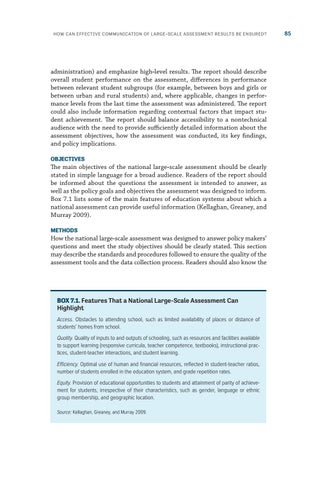How Can Effective Communication of Large-Scale Assessment Results Be Ensured?
administration) and emphasize high-level results. The report should describe overall student performance on the assessment, differences in performance between relevant student subgroups (for example, between boys and girls or between urban and rural students) and, where applicable, changes in performance levels from the last time the assessment was administered. The report could also include information regarding contextual factors that impact student achievement. The report should balance accessibility to a nontechnical audience with the need to provide sufficiently detailed information about the assessment objectives, how the assessment was conducted, its key findings, and policy implications. OBJECTIVES
The main objectives of the national large-scale assessment should be clearly stated in simple language for a broad audience. Readers of the report should be informed about the questions the assessment is intended to answer, as well as the policy goals and objectives the assessment was designed to inform. Box 7.1 lists some of the main features of education systems about which a national assessment can provide useful information (Kellaghan, Greaney, and Murray 2009). METHODS
How the national large-scale assessment was designed to answer policy makers’ questions and meet the study objectives should be clearly stated. This section may describe the standards and procedures followed to ensure the quality of the assessment tools and the data collection process. Readers should also know the
BOX 7.1. Features That a National Large-Scale Assessment Can Highlight Access. Obstacles to attending school, such as limited availability of places or distance of students’ homes from school. Quality. Quality of inputs to and outputs of schooling, such as resources and facilities available to support learning (responsive curricula, teacher competence, textbooks), instructional practices, student-teacher interactions, and student learning. Efficiency. Optimal use of human and financial resources, reflected in student-teacher ratios, number of students enrolled in the education system, and grade repetition rates. Equity. Provision of educational opportunities to students and attainment of parity of achievement for students, irrespective of their characteristics, such as gender, language or ethnic group membership, and geographic location. Source: Kellaghan, Greaney, and Murray 2009.
85

